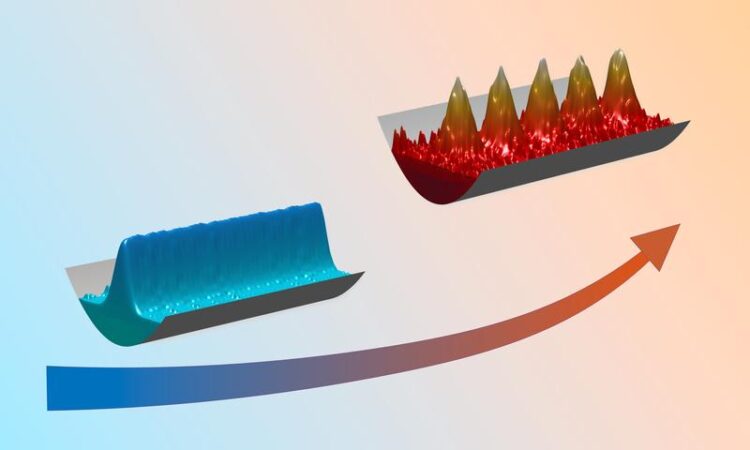Quantum liquid becomes solid when heated

When a quantum liquid is heated, crystalline structures can appear.
(c) Aarhus University
Solids can be melted by heating, but in the quantum world it can also be the other way around: In a joint effort, an experimental team led by Francesca Ferlaino in Innsbruck, Austria, and a theoretical team led by Thomas Pohl in Aarhus, Denmark, show in Nature Communications how a quantum liquid forms supersolid structures by heating. The scientists obtained a first phase diagram for a supersolid at finite temperature.
Supersolids are a relatively new and exciting area of research. They exhibit both solid and superfluid properties simultaneously. In 2019, three research groups were able to demonstrate this state for the first time beyond doubt in ultracold quantum gases, among them the research group led by Francesca Ferlaino from the Department of Experimental Physics at the University of Innsbruck and the ÖAW Institute for Quantum Optics and Quantum Information (IQOQI) in Innsbruck.
In 2021, Francesca Ferlaino’s team studied in detail the life cycle of supersolid states in a dipolar gas of dysprosium atoms. They observed something unexpected: “Our data suggested that an increase in temperature promotes the formation of supersolid structures,” recounts Claudia Politi of Francesca Ferlaino’s team. “This surprising behaviour was an important boost to theory, which had previously paid little attention to thermal fluctuations in this context.”
The Innsbruck scientists joined the force with the danish theoretical group led by Thomas Pohl to explore the effect of thermal fluctuation. They developed and published in Nature Communications a theoretical model that can explain the experimental results and underlines the thesis that heating the quantum liquid can lead to the formation of a quantum crystal. The theoretical model shows that as the temperature rises, these structures can form more easily.
“With the new model, we now have a phase diagram for the first time that shows the formation of a supersolid state as a function of temperature,” Francesca Ferlaino is delighted to say. “The surprising behavior, which contradicts our everyday observation, arises from the anisotropic nature of the dipole-dipole interaction of the strongly magnetic atoms of dysprosium.”
The research is an important step towards a better understanding of supersolid states of matter and was funded by the Austrian Science Fund FWF, the European Research Council ERC and the European Union, among others.
Wissenschaftliche Ansprechpartner:
Univ.-Prof. Dr. Francesca Ferlaino
Institut für Experimentalphysik
Universität Innsbruck
Tel.: +43 512 507 52440
E-Mail: francesca.ferlaino@uibk.ac.at
Web: http://www.erbium.at
Originalpublikation:
Heating a quantum dipolar fluid into a solid. J. Sanchez-Baena, Claudia Politi, F. Maucher, Francesca Ferlaino, and T. Pohl. Nature Communications 14, 1868 (2023) (Open Access) DOI: https://doi.org/10.1038/s41467-023-3720
Media Contact
All latest news from the category: Physics and Astronomy
This area deals with the fundamental laws and building blocks of nature and how they interact, the properties and the behavior of matter, and research into space and time and their structures.
innovations-report provides in-depth reports and articles on subjects such as astrophysics, laser technologies, nuclear, quantum, particle and solid-state physics, nanotechnologies, planetary research and findings (Mars, Venus) and developments related to the Hubble Telescope.
Newest articles

First-of-its-kind study uses remote sensing to monitor plastic debris in rivers and lakes
Remote sensing creates a cost-effective solution to monitoring plastic pollution. A first-of-its-kind study from researchers at the University of Minnesota Twin Cities shows how remote sensing can help monitor and…

Laser-based artificial neuron mimics nerve cell functions at lightning speed
With a processing speed a billion times faster than nature, chip-based laser neuron could help advance AI tasks such as pattern recognition and sequence prediction. Researchers have developed a laser-based…

Optimising the processing of plastic waste
Just one look in the yellow bin reveals a colourful jumble of different types of plastic. However, the purer and more uniform plastic waste is, the easier it is to…


